How To Manage Local Services In Windows 10
On Windows x, services are programs that run in the background without a user interface and enable organization features (such as printing, networking, remote access, File Explorer, Windows Search, updates, etc.) and apps to operate as intended.
Although the arrangement does a pretty good job managing background services, sometimes, y'all may need to control them manually when a feature or app isn't working correctly, or an app requires yous to manage its services manually.
Whatever the case information technology might exist, Windows ten includes at least 4 methods to stop, start, disable, or enable services using the Services console, Task Manager, Control Prompt, and PowerShell.
In this Windows 10 guide, we'll walk yous through the steps to manage system and apps services on your computer.
- How to manage services using Services console
- How to manage services using Task Manager
- How to manage services using PowerShell
- How to manage services using Command Prompt
How to manage services using Services panel
Using the Services consoles is perhaps the simplest method to terminate, get-go, disable, or enable one or multiple services on Windows x.
Stop service
To cease a running service using Services, utilize these steps:
- Open Start.
- Search for Services and click the top effect to open the console.
- Double-click the service that you intend to stop.
-
Click the Finish button.
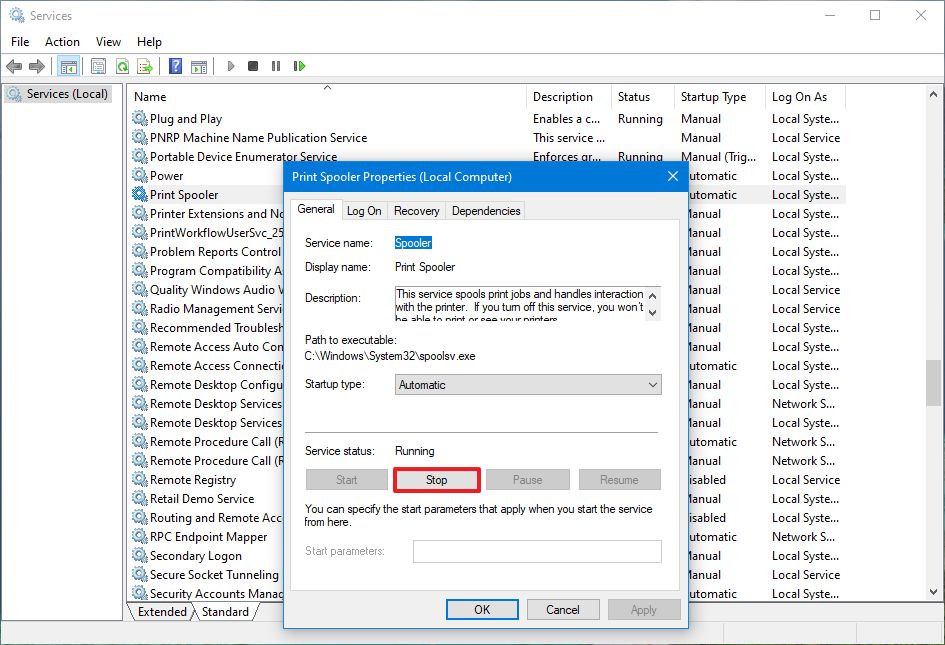 Source: Windows Key
Source: Windows Key Quick tip: You can also manage the land past right-clicking the service and selecting the option. Or you lot tin select the service and then use the controls at the top to start, cease, pause, or restart.
- Click the Apply button.
- Click the OK button.
Once yous complete the steps, the service will stop running on the device.
If yous're unable to stop a system service, consider that some services are required for the functioning of Windows 10, and they tin't exist stopped.
Beginning service
To start a service on Windows x, utilize these steps:
- Open Showtime.
- Search for Services and click the top upshot to open the console.
- Double-click the service that you intend to finish.
-
Click the Beginning button.
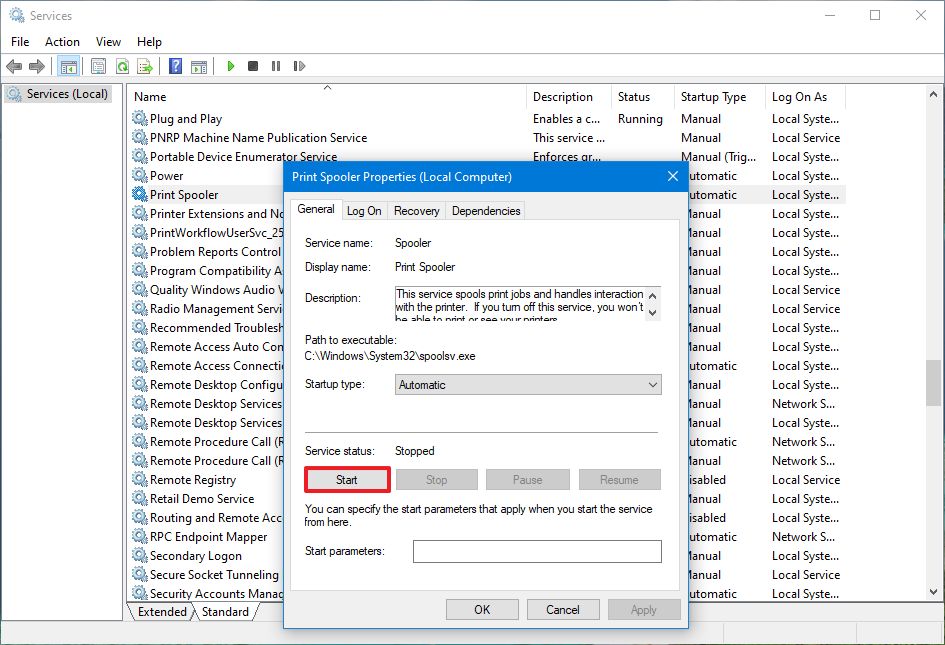 Source: Windows Central
Source: Windows Central - Click the Apply push.
- Click the OK button.
Afterwards you lot complete the steps, the service you specified will start for the current session.
Disable service
To set a service a disabled, use these steps:
- Open up Beginning.
- Search for Services and click the superlative result to open the console.
- Double-click the service that you intend to cease.
- Click the Terminate push.
-
Use the "Offset type" drop-downwardly menu and select the Disabled selection.
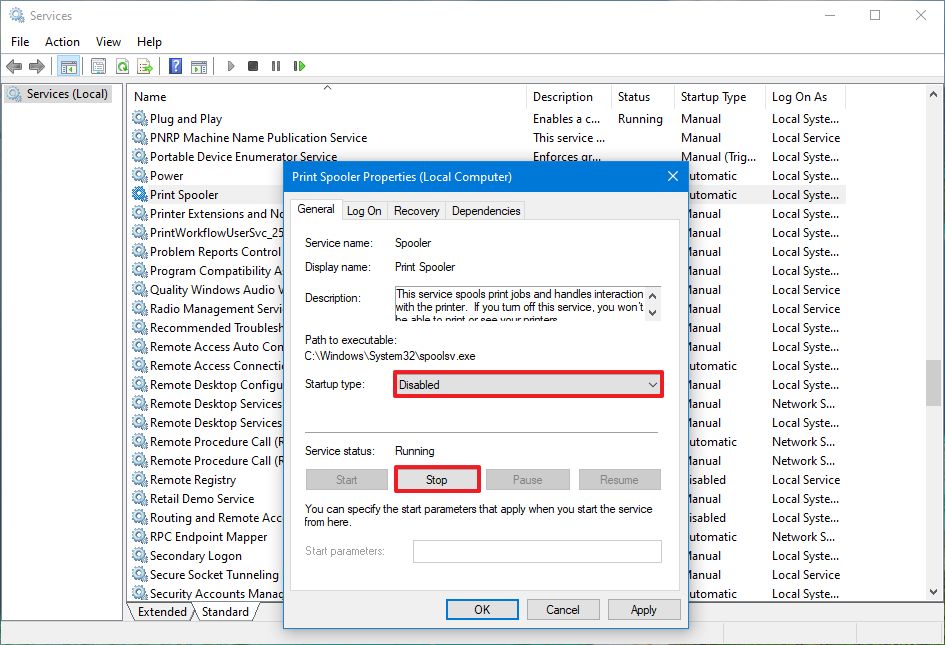 Source: Windows Central
Source: Windows Central - Click the Employ button.
- Click the OK button.
Once you complete the steps, the service will no longer kickoff automatically after restarting your device.
Enable service
To enable a specific service, employ these steps:
- Open Showtime.
- Search for Services and click the pinnacle effect to open the console.
- Double-click the service that yous intend to end.
- Click the Beginning button.
-
Use the "Start type" driblet-downwardly menu and select the Automatic option.
These are the Startup types on Windows 10:
- Automatic – service starts at boot.
- Automatic (Delayed Start) – service kickoff later on boot.
- Manual – starts service manually as needed.
- Disabled – stops service from running.
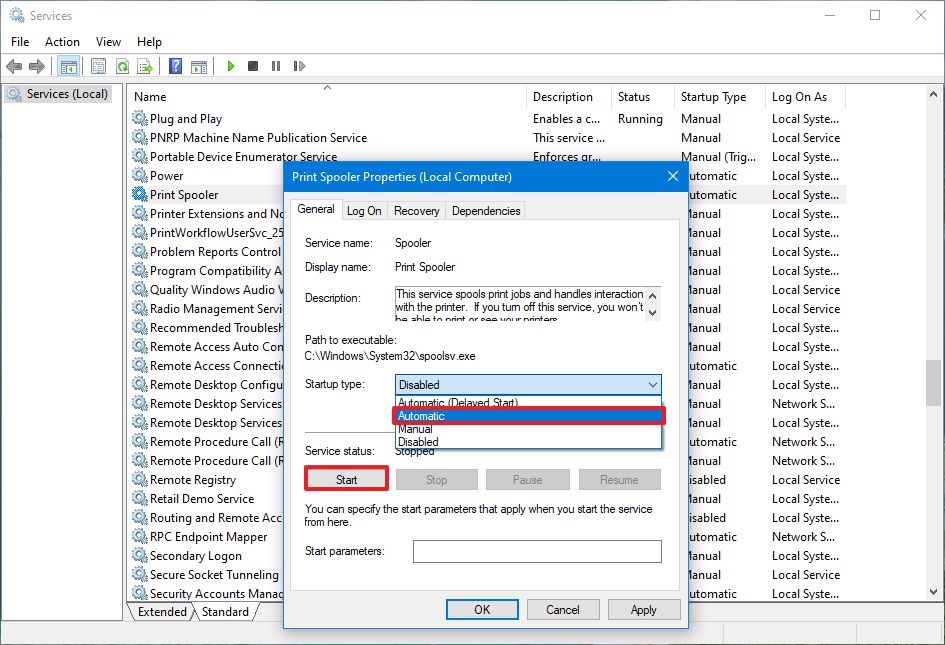 Source: Windows Central
Source: Windows Central - Click the Utilize button.
- Click the OK push.
Later you complete the steps, the Windows 10 or app service volition enable, but if it was in a stopped land, you'd need to start it manually or restart the device for the service to run.
How to manage services using Chore Manager
Task Manager also includes a section to apace manage services for Windows 10 and apps.
To cease, start, or restart a service using Task Director, use these steps:
- Open Starting time.
-
Search for Chore Director and click the pinnacle result to open the app.
Quick tip: Windows 10 includes many other ways to open up the experience, including right-clicking the taskbar and selecting the Job Manager option and using the Ctrl + Shift + ESC keyboard shortcut.
- Click the Services tab.
-
Right-click the service name, and select one of the options:
- Stop.
- Outset.
- Restart.
 Source: Windows Central
Source: Windows Central Quick annotation: Task Managing director simply displays the service name, not the display name. For example, if you lot're using this method, y'all'll the "Print Spooler" defined as "Spooler."
Once you complete the steps, the service will respond to the option yous selected.
How to manage services using PowerShell
You can besides use PowerShell commands to manage background services for Windows x and apps.
Cease service
To end a specific service with PowerShell, use these steps:
- Open Offset.
- Search for PowerShell, correct-click the top result, and select the Run as administrator option.
-
(Optional) Type the post-obit command to view a list of all the services and press Enter:
Get-Service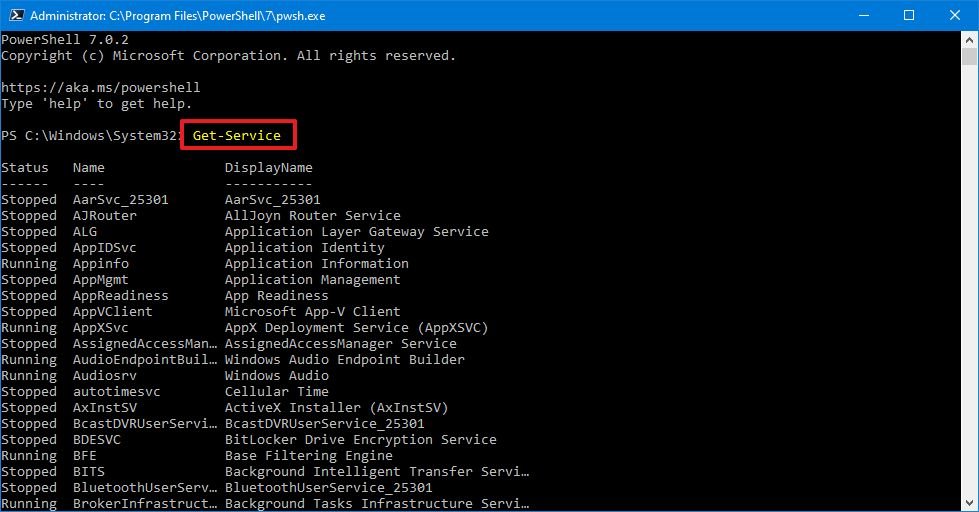 Source: Windows Central
Source: Windows Central -
Type the following command to stop a service and press Enter:
Stop-Service -Name "SERVICE-Proper noun"For example, this command stops the printer spooler service on Windows x:
Stop-Service -Name "spooler"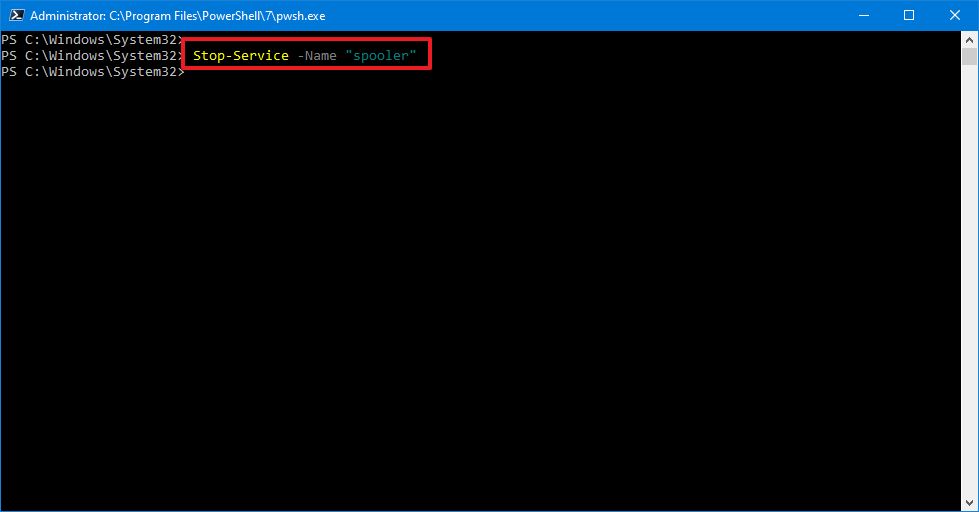 Source: Windows Primal
Source: Windows Primal In the command, replace "SERVICE-Proper noun" for the name of the service that you intend to stop. If you want to use the display name, replace
-Namefor-DisplayNameand so specify the display proper name of the service.Alternatively, yous can as well utilise this variant of the command to stop the service:
Fix-Service -Name "SERVICE-NAME" -Status stopped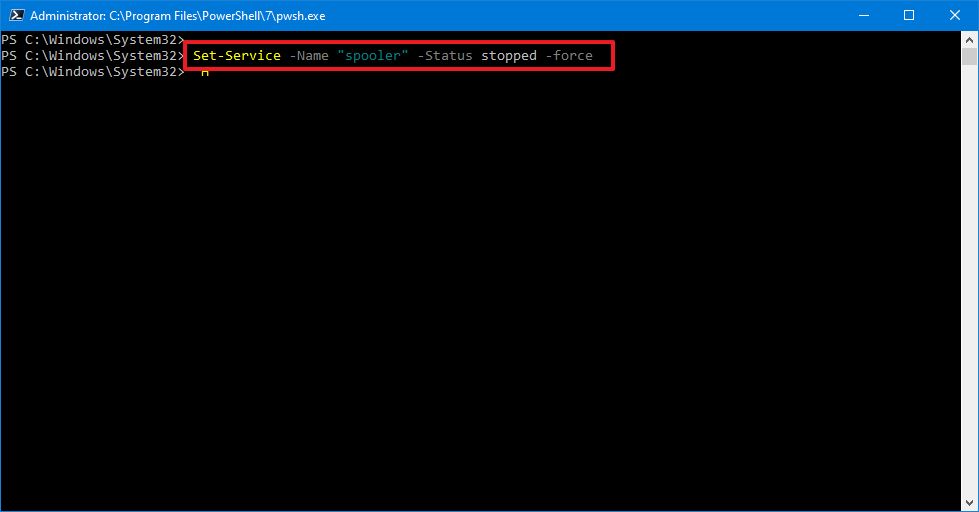 Source: Windows Key
Source: Windows Key In the command, supercede "SERVICE-Name" for the name of the service that you intend to stop. If you want to use the display proper noun, supervene upon
-Namefor-DisplayNameand and so specify the display name of the service. Yous simply demand the quotation marks if there's a space within the name.Quick tip: If y'all're getting a dependency error, you tin can append the
-forceoption in either of the commands to stop the service. For example,Stop-Service -Proper name "SERVICE-Proper noun" -Force.
Afterward yous consummate the steps, the PowerShell command volition stop the service on your device.
Start service
To start a Windows 10 or app service with PowerShell, use these steps:
- Open up Start.
- Search for PowerShell, right-click the summit consequence, and select the Run as administrator choice.
-
Type the following command to first a service and press Enter:
Beginning-Service -Name "SERVICE-Proper name"For example, this control starts the printer spooler service on Windows 10:
Start-Service -Proper name "spooler"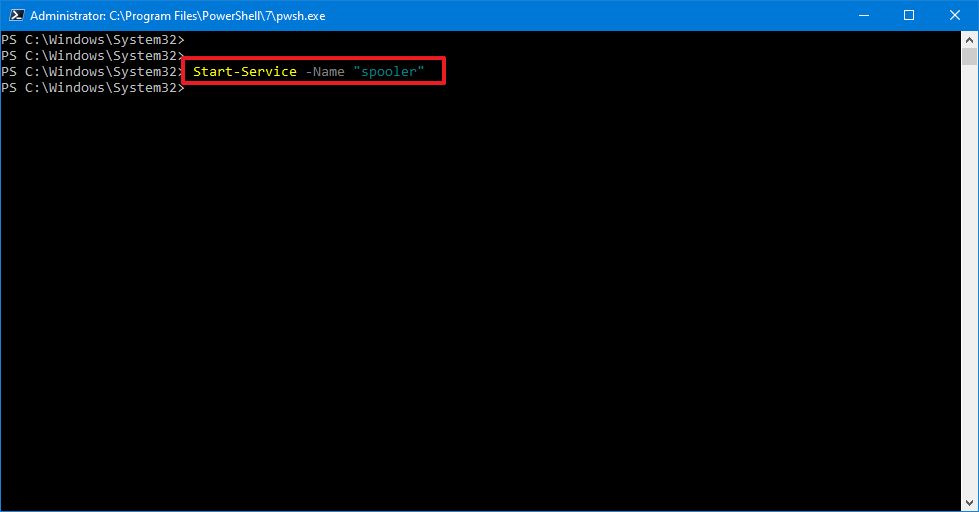 Source: Windows Central
Source: Windows Central In the command, supplant "SERVICE-Name" for the name of the service. Using the brandish proper noun is supported, replacing
-Namefor-DisplayNameand so specify the display name of the service.Alternatively, you can besides use this variant of the command to get-go a service:
Set-Service -Name "SERVICE-NAME" -Status running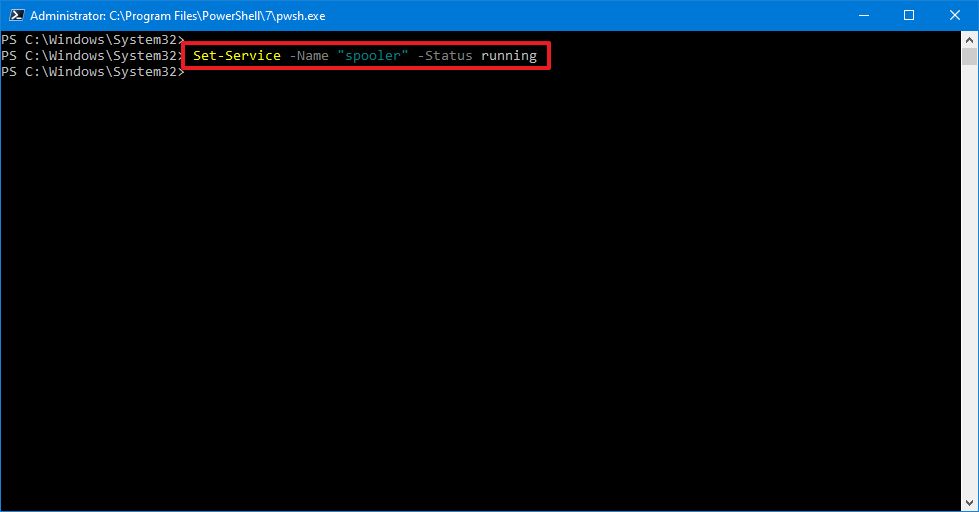 Source: Windows Cardinal
Source: Windows Cardinal In the command, replace "SERVICE-Name" for the name of the service. If you want to use the display name, supercede
-Namefor-DisplayNameand and so specify the display proper noun of the service.
Once you consummate the steps, the service will outset on your computer.
Disable service
To disable a service using a PowerShell command, use these steps:
- Open Start.
- Search for PowerShell, correct-click the top result, and select the Run every bit administrator option.
-
Type the following control to disable a service and press Enter:
Ready-Service -Proper noun "SERVICE-Proper noun" -Status stopped -StartupType disabledIn the command, update "SERVICE-Name" for the name of the service. If you want to use the display name of the service, so replace
-Namefor-DisplayNameand specify the service name. If you want to disable the service without stopping it immediately, yous can remove the-Status stoppedportion of the command.For example, this control disables the printer spooler service on Windows x:
Prepare-Service -Name "spooler" -Status stopped -StartupType disabled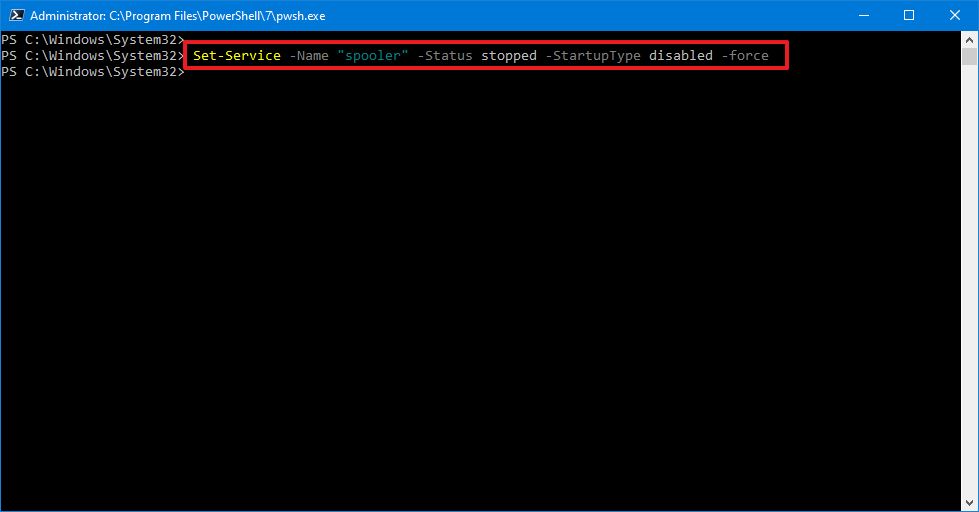 Source: Windows Central
Source: Windows Central
After you lot complete the steps, the PowerShell command will disable the specified service.
Enable service
To enable a specific background service with PowerShell, use these steps:
- Open Offset.
- Search for PowerShell, right-click the elevation effect, and select the Run as administrator option.
-
Type the following control to enable a service and printing Enter:
Set-Service -Proper noun "SERVICE-NAME" -Status running -StartupType automaticFor example, this command enables the printer spooler service using PowerShell:
Set-Service -Proper noun "spooler" -Condition running -StartupType automated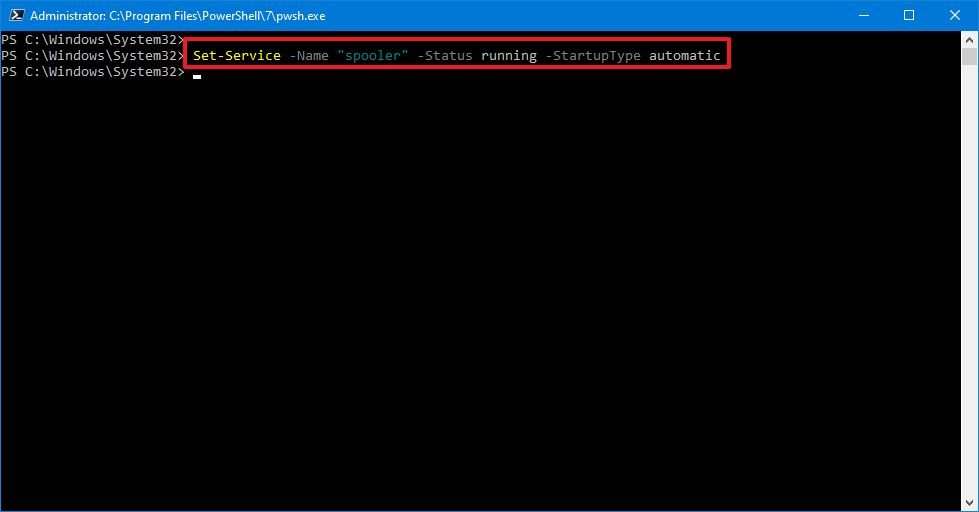 Source: Windows Central
Source: Windows Central Quick note: Y'all may able to use the brandish
-DisplayNameoption, but the control may besides prompt you to supply the name of the service, adding an extra step to the procedure. If you lot want to enable the service without starting information technology immediately, you can remove the-Status runningportion of the command.
In one case you complete the steps, PowerShell will enable the service specified with the command.
How to manage services using Control Prompt
If you're comfy using the command line, Command Prompt offers the "net" command (older) to stop or get-go, or the "sc" command (newer) to end, showtime, disable, or enable services on Windows 10.
Stop service
To terminate a Windows 10 or app service with Control Prompt, use these steps:
- Open Offset.
- Search for Control Prompt, right-click the peak result, and select the Run as ambassador option.
-
(Optional) Type the following command to view a list of all the services and press Enter:
sc queryex state=all type=service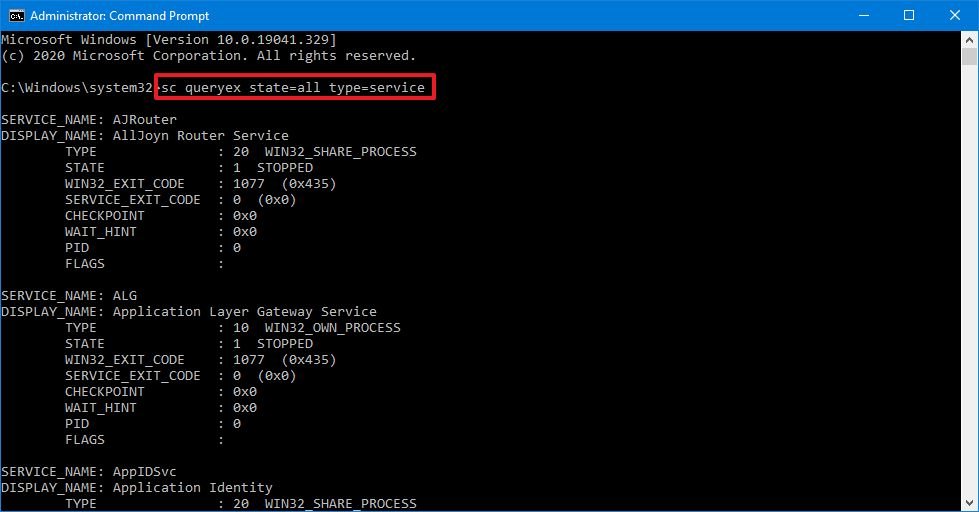 Source: Windows Central
Source: Windows Central -
Type the following command to stop a service and press Enter:
net stop "SERVICE-Name"In the command, supplant "SERVICE-Proper name" for the proper name or display name of the service. You but demand the quotation marks if there's a space within the proper noun.
For example, this command stops the printer spooler using the service proper noun:
net stop "spooler" Source: Windows Central
Source: Windows Central Alternatively, you can also apply the more advanced "sc" command:
sc terminate "SERVICE-NAME"For case, this control stops the printer spooler using the service name:
sc stop "spooler" Source: Windows Central
Source: Windows Central
Afterward yous complete the steps, the command will stop the specified service on Windows 10.
First service
To first a service with the control line, use these steps:
- Open up Starting time.
- Search for Command Prompt, right-click the superlative effect, and select the Run as ambassador choice.
-
Type the post-obit command to start a service and press Enter:
net start "SERVICE-Proper noun"In the command, replace "SERVICE-Name" for the proper name or display name of the service. You only need the quotation marks if there's a space within the name.
For example, this control starts the printer spooler using the service name:
net outset "spooler"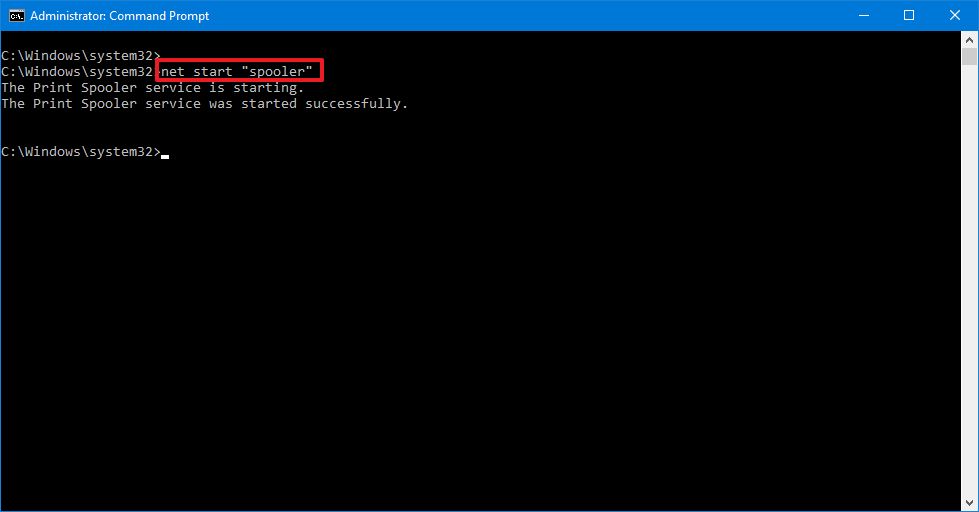 Source: Windows Central
Source: Windows Central Alternatively, you can too apply the "sc" command:
sc start "SERVICE-Name"For example, this command starts the printer spooler using the service name:
sc first "spooler" Source: Windows Central
Source: Windows Central
Once yous complete the steps, the command volition execute and start the service you specified.
Disable service
To disable a service with Control Prompt, use these steps:
- Open Showtime.
- Search for Command Prompt, right-click the height issue, and select the Run as administrator option.
-
Type the following command to disable a service and press Enter:
sc config "SERVICE-NAME" showtime=disabledIn the command, replace "SERVICE-NAME" for the name of the service that you want to disable.
For case, this control disables printer spooler using the service proper name:
sc config "spooler" start=disabled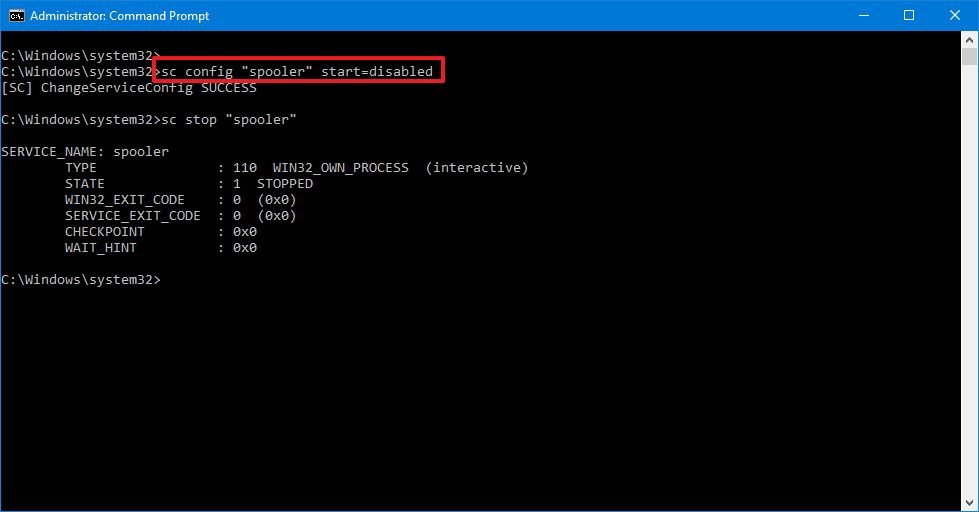 Source: Windows Fundamental
Source: Windows Fundamental -
(Optional) Blazon the post-obit control to stop the service and press Enter:
sc cease "SERVICE-Proper name"Quick annotation: When you disable a service, it doesn't terminate the current country of the service. You tin can either restart your estimator or stop the service using the in a higher place command.
After you lot complete the steps, the sc command will run disabling the Windows 10 or app service you specified.
Enable service
To enable a service with a command, use these steps:
- Open Kickoff.
- Search for Command Prompt, right-click the acme result, and select the Run equally administrator choice.
-
Type the post-obit control to enable a service and press Enter:
sc config "SERVICE-Proper name" start=autoIn the command, supplant "SERVICE-NAME" for the name of the service that you want to enable.
For case, this command enables the printer spooler automatically using the service proper name:
sc config "spooler" commencement=machine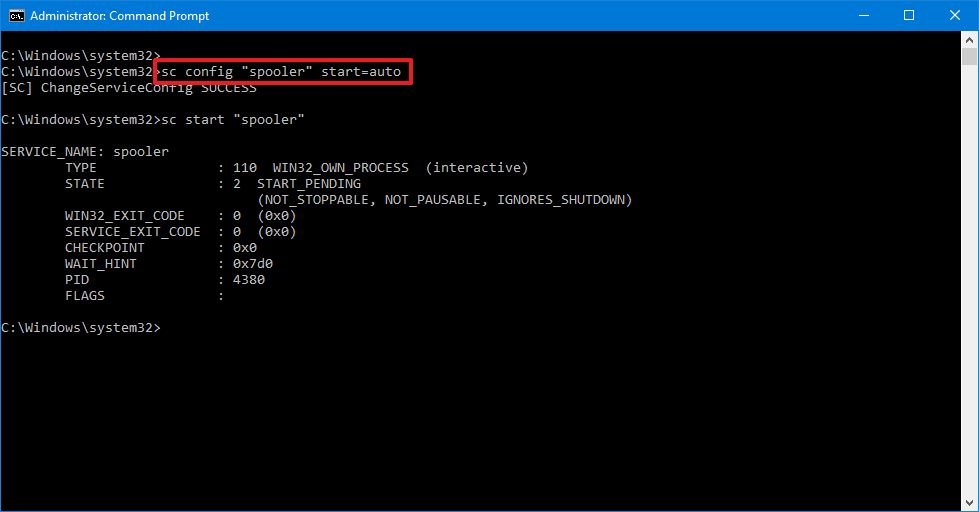 Source: Windows Central
Source: Windows Central These are alternative commands to enable a particular service:
- Manual:
sc config "SERVICE-Proper noun" start=need - Automated Delayed:
sc config "SERVICE-NAME" start=delayed-auto
- Manual:
-
(Optional) Type the post-obit command to first the service and printing Enter:
sc first "SERVICE-Proper noun"
Once you lot complete the steps, the service will enable and start automatically on reboot according to the command you used.
You tin can only utilize the "net" command to showtime or stop services. The "sc" command allows yous to perform more tasks, including start, stop, enable, or disable services, amongst other options. If you're choosing to manage services with command lines, then, in either instance, it'southward best to use the service name instead of the display proper noun.
Also, when using any of the methods outlined above, consider that making modifications to the default settings can alter the functioning of one or more features that depend on that service negatively affecting the experience. Furthermore, if you restart a service, you might be required to start its dependencies manually equally well to brand the app or feature operational once again.
We're focusing this guide on Windows 10, but the ability to manage services has been bachelor for several years, which means that you lot can refer to this guide if you're still running Windows viii.1, Windows 7, and older versions.
More Windows ten resources
For more helpful articles, coverage, and answers to common questions about Windows 10, visit the following resources:
- Windows ten on Windows Central – All you lot need to know
- Windows 10 help, tips, and tricks
- Windows 10 forums on Windows Central
How To Manage Local Services In Windows 10,
Source: https://www.windowscentral.com/how-start-and-stop-services-windows-10
Posted by: bartondidliverse.blogspot.com





















0 Response to "How To Manage Local Services In Windows 10"
Post a Comment